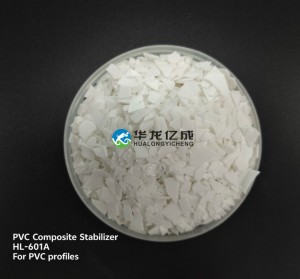Guangdong Hualong Yicheng New Materials Technology Co., Ltd. – As a professional manufacturer in the field of PVC stabilizers for many years, Hualong Yicheng has recently observed that some PVC product manufacturers in the market have intentionally or unintentionally reduced the amount of lead stabilizer added in pursuit of short-term cost reduction. We are deeply concerned about this and solemnly remind colleagues in the industry: Insufficient lead stabilizer addition is by no means a good way to reduce costs, but a major hidden danger of product quality deterioration, safety hazards and even legal risks!
Lead stabilizers have long played a key role in PVC processing. Their core function is to inhibit the degradation reaction of PVC resin caused by heat and light during high-temperature processing and subsequent use. However, the full play of its effectiveness is highly dependent on scientific and sufficient addition. When the addition amount is lower than the critical value of the formula design, a series of chain negative effects will be triggered:
1. Initial hue deteriorates and appearance quality decreases:
The most intuitive manifestation is that PVC products appear obviously yellowing or reddish during the processing process (such as extrusion, calendering, injection molding). This is because insufficient stabilizers cannot effectively capture the hydrogen chloride produced by the decomposition of PVC, resulting in the premature and excessive formation of conjugated double bond structures (chromophores).
The surface of the product may lose its luster and present a dull and uneven color, which seriously affects the aesthetics and market acceptance of the product.
2. The processing stability drops sharply and the scrap rate soars:
The processing window becomes narrower, and the material is more likely to undergo local overheating and decomposition in the processing equipment (such as screws and molds), resulting in black spots, crystal points, bubbles and even burning.
The melt strength decreases, which may lead to abnormal extrusion expansion, rough surface, obvious flow marks, and even broken strips and broken films.
The direct result is that the production line is frequently stopped for cleaning, the scrap rate increases significantly, and the actual production cost increases instead of decreasing.
3. Long-term thermal stability is seriously insufficient and the service life is shortened:
In the use environment of PVC products (especially when exposed to heat and light conditions), the internal degradation reaction will continue. Insufficient addition means that the "protective power" of the stabilizer is exhausted prematurely.
The products will accelerate the occurrence of problems such as color deepening (eventually turning brown or black), surface powdering, embrittlement, and significant decrease in strength (tensile strength, impact strength), resulting in premature product failure and failure to meet the design service life requirements.
4. Deterioration of physical and mechanical properties, and questionable reliability:
The degradation process destroys the molecular chain structure of PVC, resulting in decreased toughness, increased brittleness, and weakened impact resistance.
Key indicators such as modulus and hardness may also deviate from the design value, affecting the dimensional stability and load-bearing capacity of the product. This is particularly dangerous for applications with high load-bearing requirements such as pipes, profiles, wires and cables.
5. Potential lead precipitation risks and regulatory compliance issues:
Although the lead stabilizer itself has good long-term fixation of lead when the formula is reasonable and the processing is proper, insufficient addition leads to product structural degradation (such as powdering, surface damage) and may increase the risk of lead precipitation, especially in contact with water, acidic environment or friction conditions.
This directly touches on increasingly stringent environmental regulations (such as EU RoHS, REACH, and relevant Chinese environmental regulations) and mandatory safety standards for specific application areas such as food contact, toys, and medical. Once the lead precipitation exceeds the standard, the company will face product recall, huge fines, serious damage to brand reputation and even legal proceedings.
Professional insights and suggestions:
Strictly follow the formula science: The design of PVC formula is a rigorous scientific process. The amount of lead stabilizer added needs to comprehensively consider factors such as PVC resin type, processing technology (temperature, time), final product performance requirements, and the synergistic/antagonistic effects of other additives (such as plasticizers and lubricants). Any reduction behavior that has not been fully verified is full of risks.
The right way to control costs: Simply reducing the amount of stabilizer is "drinking poison to quench thirst". Sustainable cost reduction is achieved by optimizing process parameters (lowering processing temperature, shortening residence time), selecting more efficient stabilizer systems (such as composite stabilizers) or cooperating with reliable stabilizer suppliers to develop more cost-effective formulas.
Embrace the trend of environmentally friendly substitution: In view of the environmental pressure and potential risks of lead stabilizers, the industry's transformation to environmentally friendly stabilizers such as calcium zinc stabilizers, organic tin stabilizers (specific applications), and rare earth stabilizers is a general trend. As an industry pioneer, Hualong Yicheng continues to invest in research and development to provide high-performance, safe, and compliant environmentally friendly stabilizer solutions (1-2 star environmentally friendly product series can be briefly mentioned here), which can not only fully meet or even exceed the performance requirements of lead stabilizers, but also help customers successfully pass the stringent international and domestic environmental regulations and enhance product competitiveness and brand image.
Hualong Yicheng calls for: PVC product manufacturers should attach great importance to the scientific use of stabilizers. Don't lose the big picture for the small, and let the fluke mentality of "cutting corners" damage product quality, user safety and long-term development of the company. We are willing to work with colleagues in the industry to jointly promote the PVC industry towards higher quality, safer and more environmentally friendly direction!
About Hualong Yicheng:
Guangdong Hualong Yicheng New Materials Technology Co., Ltd. is a leading PVC heat stabilizer R&D and manufacturer in China, focusing on providing high-performance, environmentally friendly and safe stabilization solutions. With 23 years of industry experience and a complete quality management system, it is committed to helping customers meet challenges and achieve sustainable development. "

Post time: Jun-04-2025

